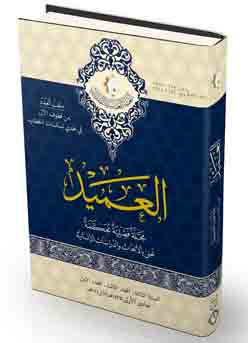Abstract
Euphemism is a common language phenomenon used to replace
a direct, offensive, annoying, and prohibited word or expression
with a roundabout, inoffensive, pleasant, and acceptable one
so as to save both the speaker’s and hearer’s face or third party
from any loss.
Euphemism serves many functions; it may be used to soften the
taboos (sex, religion, death, disease, pregnancy, and excrement), to
deceive people (this is common in political situations), to show politeness,
humour, solidarity and respect. In Shakespeare's Measure
for Measure, these functions and many others are taken into account.
This study attempts to achieve the following aims: (i) finding a
model of pragmatic analysis of euphemism for Measure for Measure,
(ii) identifying what euphemistic expressions used in this play,
(iii) illustrating how context helps understand the euphemistic
expressions in the play, (iv) knowing the reason(s) behind characters'
infringement of Grice’s Cooperative Principle’s conversational
maxims and (v) showing how the subjects of Measure for Measure
such as sex, religion, death, disease, pregnancy, and excrement are
mirrored through the employment of euphemism. The following
hypotheses have been suggested:
(1) the interpretation of euphemism in Measure for Measure
greatly relies on context, (2) the characters of the play use euphemism
deliberately, (3) often euphemism serves more than one function
in one utterance and (4) the subjects of sex and pregnancy are
granted great interest in Measure for Measure than others (disease,
religion, death, excrement).
The conclusions of the research validate the above hypotheses
a direct, offensive, annoying, and prohibited word or expression
with a roundabout, inoffensive, pleasant, and acceptable one
so as to save both the speaker’s and hearer’s face or third party
from any loss.
Euphemism serves many functions; it may be used to soften the
taboos (sex, religion, death, disease, pregnancy, and excrement), to
deceive people (this is common in political situations), to show politeness,
humour, solidarity and respect. In Shakespeare's Measure
for Measure, these functions and many others are taken into account.
This study attempts to achieve the following aims: (i) finding a
model of pragmatic analysis of euphemism for Measure for Measure,
(ii) identifying what euphemistic expressions used in this play,
(iii) illustrating how context helps understand the euphemistic
expressions in the play, (iv) knowing the reason(s) behind characters'
infringement of Grice’s Cooperative Principle’s conversational
maxims and (v) showing how the subjects of Measure for Measure
such as sex, religion, death, disease, pregnancy, and excrement are
mirrored through the employment of euphemism. The following
hypotheses have been suggested:
(1) the interpretation of euphemism in Measure for Measure
greatly relies on context, (2) the characters of the play use euphemism
deliberately, (3) often euphemism serves more than one function
in one utterance and (4) the subjects of sex and pregnancy are
granted great interest in Measure for Measure than others (disease,
religion, death, excrement).
The conclusions of the research validate the above hypotheses
Abstract
التلطف ظاهرة لغوية شائعة تستعمل لغرض استبدال كلمة او عبارة مباشرة،
اومهينة، او مزعجة، اومحرمة بكلمة غير مباشرة، او غير مؤذية، او لطيفة، او مقبولة
لغرض حفظ ماء وجه المتكلم والمستمع، او اي طرف ثالث من اي ضرر، او احراج.
ظاهرة التلطف تقوم بالعديد من الوظائف:اذ تستعمل لتلطيف الموضوعات
المحرمة )الجنس والدين والموت والمرض والحمل والغائط(. كذلك تستعمل
لتضليل الناس )وهي شائعة في المواقف السياسية(. فضلا عن ذلك توظف لاظهار
الادب والفكاهه وتقوية الاواصر والاحترام. هذه الوظائف وغيرها استعملت في
مسرحية شكسبير العين بالعين.
تحاول الرسالة الحالية تحقيق الاهداف التالية: ) 1( ايجاد نظرية تحليلية تداولية
لظاهرة التلطف في مسرحية العين بالعين، ) 2( تحديد نوعية التعابير الملطفة التي
تستعمل في مسرحية العين بالعين، ) 3( توضيح اهمية السياق في فهم التعابير الملطفة
في المسرحية المذكورة، ) 4( معرفه السبب او الاسباب التي جعلت الشخصيات
تنتهك مبدا التعاون وقوانيين الحوار، ) 5( بيان كيفية انعكاس موضوعات المسرحية
)الجنس والدين والموت والمرض والحمل والغائط( من خلال استعمال التلطف،
وقد اقترحت الدراسة الفرضيات التالية:
1. فهم التلطف في المسرحية يعتمد السياق بصورة كبيرة.
2. تستعمل الشخصيات في المسرحية التلطف بصورة مقصودة.
3. غالبا ما يؤدي التلطف اكثر من وظيفة في الجملة الواحدة.
4. موضوعات الجنس والحمل شكلت اهتمام كبيرا في مسرحية العين بالعين
عن بقية الموضوعات )المرض والدين والموت والغائط(.
وان استقصاء المسرحيتين اثبت صحة الفرضيات أعلاه.
اومهينة، او مزعجة، اومحرمة بكلمة غير مباشرة، او غير مؤذية، او لطيفة، او مقبولة
لغرض حفظ ماء وجه المتكلم والمستمع، او اي طرف ثالث من اي ضرر، او احراج.
ظاهرة التلطف تقوم بالعديد من الوظائف:اذ تستعمل لتلطيف الموضوعات
المحرمة )الجنس والدين والموت والمرض والحمل والغائط(. كذلك تستعمل
لتضليل الناس )وهي شائعة في المواقف السياسية(. فضلا عن ذلك توظف لاظهار
الادب والفكاهه وتقوية الاواصر والاحترام. هذه الوظائف وغيرها استعملت في
مسرحية شكسبير العين بالعين.
تحاول الرسالة الحالية تحقيق الاهداف التالية: ) 1( ايجاد نظرية تحليلية تداولية
لظاهرة التلطف في مسرحية العين بالعين، ) 2( تحديد نوعية التعابير الملطفة التي
تستعمل في مسرحية العين بالعين، ) 3( توضيح اهمية السياق في فهم التعابير الملطفة
في المسرحية المذكورة، ) 4( معرفه السبب او الاسباب التي جعلت الشخصيات
تنتهك مبدا التعاون وقوانيين الحوار، ) 5( بيان كيفية انعكاس موضوعات المسرحية
)الجنس والدين والموت والمرض والحمل والغائط( من خلال استعمال التلطف،
وقد اقترحت الدراسة الفرضيات التالية:
1. فهم التلطف في المسرحية يعتمد السياق بصورة كبيرة.
2. تستعمل الشخصيات في المسرحية التلطف بصورة مقصودة.
3. غالبا ما يؤدي التلطف اكثر من وظيفة في الجملة الواحدة.
4. موضوعات الجنس والحمل شكلت اهتمام كبيرا في مسرحية العين بالعين
عن بقية الموضوعات )المرض والدين والموت والغائط(.
وان استقصاء المسرحيتين اثبت صحة الفرضيات أعلاه.
